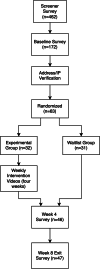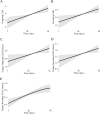Evaluating a mobile app's effects on depression and anxiety in medication-treated opioid use disorder
- PMID: 39349617
- PMCID: PMC11443057
- DOI: 10.1038/s44184-024-00086-7
Evaluating a mobile app's effects on depression and anxiety in medication-treated opioid use disorder
Abstract
Depression and anxiety frequently co-occur with opioid use disorder (OUD) yet are often overlooked in standard OUD treatments. This study evaluated the feasibility, acceptability, and preliminary effectiveness of a mobile application designed to address these symptoms in individuals receiving medications for OUD (MOUD). A randomized controlled trial recruited N = 63 adults with OUD who received MOUD and screened positive for moderate depression or generalized anxiety. Participants were randomized to an app-based digital intervention or treatment-as-usual for 4 weeks, and completed follow-ups at 4 and 8 weeks. Primary outcomes were self-reported severity measures for depression and generalized anxiety, and urine drug screens (UDS). Secondary outcomes included self-reported OUD severity, craving intensity, and digital biomarkers derived from passive smartphone sensors. The application was well-received (median app rating = 4/5 stars). The intervention group showed significant reductions in depressive and generalized anxiety symptoms post-intervention and at 8 weeks follow-up (d > 0.70), with large (d = 0.78) and moderate (d = 0.38) effect sizes, respectively, compared to controls. Both groups exhibited substantial decreases in self-reported severity of opioid use symptoms (d > 2.50). UDS suggested similar between-group adherence to MOUD, with a marginal decrease in opioid (MOP) use in the intervention group and increase in controls, yielding medium between group effect sizes (d = 0.44). Passive sensor data suggested significant increases in social connectedness in the intervention group, evidenced by a significant rise in incoming and outgoing calls and text connections. Initial evidence supports the feasibility and acceptability of a digital intervention for treating anxiety and depressive symptoms in persons receiving MOUD. While underpowered to confidently determine statistical significance beyond directionality, the intervention showed promise in reducing depressive and anxiety symptoms, suggesting its potential as a cost-effective and scalable adjunctive therapy alongside standard OUD treatment. Due to the preliminary nature of this pilot study, further research with sample sizes permitting greater statistical power is needed to confirm findings and explore long-term effects.
© 2024. The Author(s).
Conflict of interest statement
L.M. has an affiliation with Square2 Systems, Boehringer Ingelheim, and Click Therapeutics. These relationships are extensively managed by her employer, Dartmouth College. N.C.J. has a received grant from Boehringer Ingelheim. N.C.J. has edited a book through Academic Press and receives book royalties, and N.C.J. also receives speaking fees related to his research.
Figures





Similar articles
-
Efficacy of Integrating the Management of Pain and Addiction via Collaborative Treatment (IMPACT) in Individuals With Chronic Pain and Opioid Use Disorder: Protocol for a Randomized Clinical Trial of a Digital Cognitive Behavioral Treatment.JMIR Res Protoc. 2024 Mar 20;13:e54342. doi: 10.2196/54342. JMIR Res Protoc. 2024. PMID: 38506917 Free PMC article.
-
Adapting behavioral activation for patients receiving medications for opioid use disorder in primary care: a pilot study.Front Psychol. 2024 Oct 8;15:1439946. doi: 10.3389/fpsyg.2024.1439946. eCollection 2024. Front Psychol. 2024. PMID: 39439755 Free PMC article.
-
Feasibility and impact of a mental health chatbot on postpartum mental health: a randomized controlled trial.AJOG Glob Rep. 2023 Mar 29;3(3):100165. doi: 10.1016/j.xagr.2023.100165. eCollection 2023 Aug. AJOG Glob Rep. 2023. PMID: 37560011 Free PMC article.
-
Behavioural modification interventions for medically unexplained symptoms in primary care: systematic reviews and economic evaluation.Health Technol Assess. 2020 Sep;24(46):1-490. doi: 10.3310/hta24460. Health Technol Assess. 2020. PMID: 32975190 Free PMC article.
-
Telephone interventions for symptom management in adults with cancer.Cochrane Database Syst Rev. 2020 Jun 2;6(6):CD007568. doi: 10.1002/14651858.CD007568.pub2. Cochrane Database Syst Rev. 2020. PMID: 32483832 Free PMC article.
References
-
- National Institute on Drug Abuse. How much does opioid treatment cost? National Institute on Drug Abusehttps://nida.nih.gov/publications/research-reports/medications-to-treat-... (2017).
Grants and funding
LinkOut - more resources
Full Text Sources

